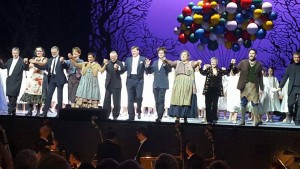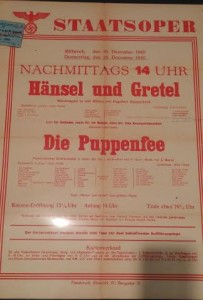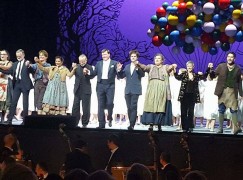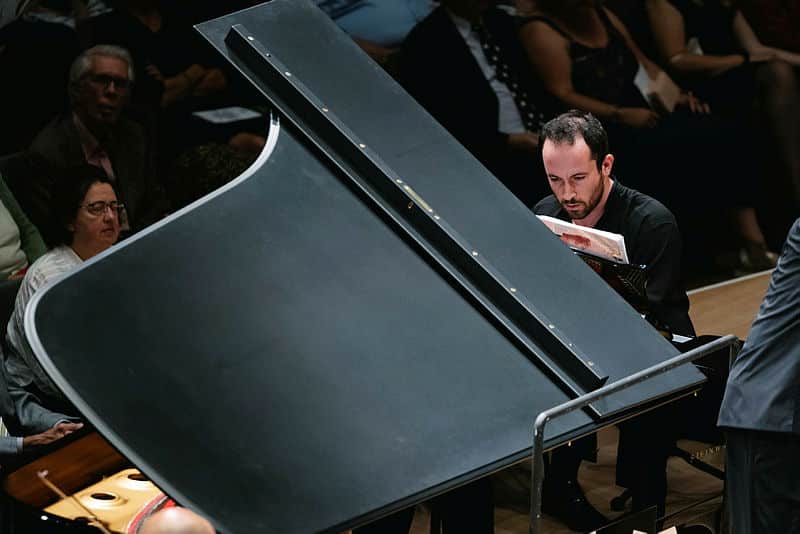Hansel revisits Vienna after 70 years
mainThis was last night’s curtain call.

And this, below, was the showbill for the Vienna State Opera’s last production of Hansel and Gretel, which ended when the house was shut by Goebbels in 1944.
Note the emblem in the upper lefthand corner and the casual assumption that, in Vienna at least, Hansel and Gretel was only half of a mandatory double-bill.
Sitzfleisch must have softened since then.







A similar symbol, an eagle holding a swastika in its talons circumscribed by the words “Orchester der Hauptstadt der Bewegung” (Orchestra of the capital city of the Movement) was stamped on the music of the Munich Philharmonic during the Third Reich. (Munich is where Hitler formed and built the Nazi party. The city proudly claimed to be the Capital City of the Movement and made those words part of the municipal logo.) After the war the words were blotted out, but for some reason the swastikas were left untouched. During the 13 years my wife was in the orchestra, the swastikas regularly appeared on works like Ein Heldenleben and the Waltzes the orchestra used for its yearly Ball.
In 1991 I wrote to the cultural ministry and asked that they have the orchestra remove the swastikas. The orchestra lied and said there weren’t any on their music, so I sent photocopies to several city council members. The orchestra then agreed to remove them (but I’m not sure they ever did.)
William, you make me very curious.
By “swastikas regularly appeared on works like Ein Heldenleben” do you mean that they were on the parts the musicians played from? If so, do you know how they swastikas ended up there in the first place?
They were on the all the musicians’ parts. They were put on with a rubber stamp (or something like one) during the Third Reich to show that the orchestra owned the parts. What I never figured out was why they blotted out the words “Orchestra of the Capital City of the Movement” but never touched the swastikas.
During the Third Reich, the Munich Phil often referred to itself as the Orchestra of the Fascist Movement. Even though it toured widely during the Reich and was favored by the Nazis, the war brought the orchestra much misfortune. In 1944 its hall, the Tonhalle, was destroyed by American bombers. The orchestra did not get a new hall until 1984, and it has notoriously bad acoustics.
The orchestra’s conductor during the Third Reich was Ostwald Kabasta who joined the Nazi Party in 1938. In same year, he testified to the Nazi authorities that he never hired a Jew during his tenure with the Vienna Philharmonic. On the other hand, he programmed Mahler and Bartok whose music was forbidden.
Some of the Jewish musicians in the orchestra committed suicide after thez were removed from their jobs.
During the de-Nazification process after the war, Ostwald Kabasta in turn received a Berufsverbot (a stipulation that he could no longer practice his profession as a conductor) due to his active collaboration with the regime. He committed suicide a few days later – part of a massive number of suicides in Germany that took place as the Reich collapsed and during the months afterwards including 54 Generals.
Goodness! How could your wife stand to work with a group who are obviously still Nazi?? Munich and Vienna are still rotten to the core, every clear thinking person knows this
Agreed! At least she had the common sense to leave but why wait so long? 13 years wasted.
Agreed! At least she had the common sense to leave but why wait so long? 13 years wasted..
RTCBOB1 and RTCBOB2?
I’m sorry to respond so late. I agree that Munich and Vienna have political cultures and forms of xenophobia that are problematic. I have never felt comfortable in either city, but by the time my wife entered the Munich Phil in 1980, there were very few Nazis or Nazi sympathizers in the orchestra — though there were quite a few members who were misogynistic. There were only 7 women in the orchestra in 1980.
By 1980, the swastikas were left on the music out of force of habit. Munich was the most Nazi of all of Germany’s cities and built many Nazi buildings and monuments. After the war many of these buildings were left standing because they were still useful and much needed. The Haus der Kunst built for Hitler was a very important symbol that is still used as a major museum. The State University of Music is housed in Hitler’s personal office building. It’s called the Führerbau. The Munich Accords that partitioned Czechoslovakia were completed in the building. There are also stories that people were tortured in the basement where the student cafeteria now is. After the war, Nazi symbols in some odd way became a part of the history of Munich’s daily life.
On the other hand, it could be that I am being a bit to forgiving. I still can’t say for sure why the swastikas were never removed.
I decided to ask that the swastikas be blotted out after a young Israeli woman named Tali Steiner was refused tenure in the Munich Phil because her colleagues said she was too fat, and other equally ridiculous complaints. She is a fantastic violinist. I and quite a few others felt anti-Semitism was involved. It also made me especially angry because the concertmaster of the Munich Phil during the Third Reich was removed from his position. He and his wife committed suicide. After Tali left, some of the members of the orchestra organized a memorial concert for the concertmaster. Sadly, I can’t remember his name and I can’t find it on the web.
Tali returned to Israel and eventually got a job in the Israel Philharmonic. Today she is one of the violinists in the Israel String Quartet. It’s one of those stories that shows concretely the value of Israel’s existence.
I don’t think it is correct to say that Hansel Revisits Vienna After 70 Years since the work has been heard at the Volksoper. What can be said is that for 61 (not 70) years the Vienna State Opera has not had the work in repertoire. According to Chronik der Wiener Staatsoper, the last time the work was performed by the company was on December 26 1954, in the Volksoper building. Since that time, the troupe of the Volskoper has presented Hansel and Gretel.
It is true that for 70 years the Vienna State Opera has not played Hansel in their own building. But this is different from what the headline tells us.
Let’s get the facts, Mr. Lebrecht.
The archive section of the Staatsoper website gives the last performance of the previous production as having taken place on 23rd June 1958, so its more like 57 and a half years since the work was last heard there.
(Oh God!)
And your point is……
At the Met in the 20s through the 40s, H&G was almost never played by itself. Tickets were cheaper (even adjusting for inflation) and you got more. Humperdinck played with everything from Pagliacci to Bernard Rogers’ The Warrior. In 1938, too, Elektra with Rose Pauly was given in tandem with Menotti’s Amelia al Ballo.